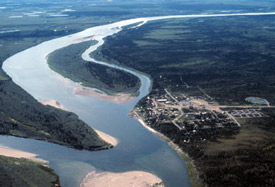Ambler
Ambler (Ivisaappaat in the local Inupiaq language) is located on the north bank of the Kobuk River, near the confluence of the Ambler and the Kobuk Rivers. It lies within the Northwest Arctic Borough, is 138 miles northeast of Kotzebue, and is 45 miles north of the Arctic Circle. The residents of Ambler are Kuuvangmiut Inupiat Eskimos. Ambler was permanently settled in 1958 when people from Shungnak and Kobuk moved upstream seeking fish and game resources. The community was named for a tributary of the Kobuk River, which was named for Dr. James M. Ambler, a U.S. Navy surgeon with the Arctic expedition under the command of Lt. Comdr. G.W. DeLong who perished in 1881 after their ship was trapped in the Arctic ice. Onion Portage, a key archaeological site for the understanding of Alaska’s human past, is located near Ambler. The tribal government is called the Native Village of Ambler. Subsistence is a major part of the local economy. Birch baskets, fur pelts, and jade, quartz, bone, and ivory carvings created in Ambler are sold in gift shops throughout the state. The estimated population in 2011 was 276.
Unfortunately, elders from Ambler were not able to visit Fairbanks and look at the material from their community that is housed at the University of Alaska Fairbanks.

